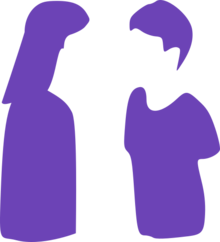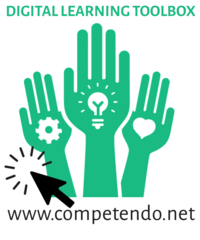|
|
| (32 intermediate revisions by the same user not shown) |
| Line 1: |
Line 1: |
| − | <div class="left-column-contentinner"> | + | <div class="methodpage-content"> |
| − | [[File:Created-by.png | 20px | Created By ]] [[User:Nils.zimmermann | N. Zimmermann]]
| + | <div class=teaser-text><div style="background: #eee; float: left; padding: 0px 5px 0px 5px; margin-right: 5px;"><i class="fas fa-arrow-left"> </i> [[During]]</div> [[File:Mentoring.png | 220px | right]]Mentoring is a relationship between people with different levels of experience. Its main goal is to enable learning and growth, often understood as non-formal practical learning. The more experienced mentor guides the mentee for a certain duration of time. In general mentoring is a tool for personal and professional development. The uniqueness of the mentoring comes along with its grand source of intrinsic motivation, support and understanding. It depends from a more personalized relation between the mentor and the mentee. |
| − | <div class=teaser-text>[[File:Mentoring.png | 220px | right]]Mentoring is a relationship between people with different levels of experience. Its main goal is to enable learning and growth, often understood as non-formal practical learning. The more experienced mentor guides the mentee for a certain duration of time. In general mentoring is a tool for personal and professional development. The uniqueness of the mentoring comes along with its grand source of intrinsic motivation, support and understanding. It depends from a more personalized relation between the mentor and the mentee that is not usual for other forms of learning. | |
| | </div> | | </div> |
| | | | |
| | Today there are numerous programmes that create more focused structures for mentor-mentee relationships, which can take place in companies, in institutions, universities, schools, or social work. They formalize the traditional informal mentoring relation in programs and use in this way mentoring as an approach of competency-based learning. | | Today there are numerous programmes that create more focused structures for mentor-mentee relationships, which can take place in companies, in institutions, universities, schools, or social work. They formalize the traditional informal mentoring relation in programs and use in this way mentoring as an approach of competency-based learning. |
| | + | |
| | + | <div class=left-box> |
| | + | ===Mentoring: Definition=== |
| | + | Mentoring represents an informal relationship between two people. An (often older) mentor supports a (less experienced) mentee by sharing his or her own personal experience and expertise, motivating and encouraging, advising and coaching. |
| | + | </div> |
| | + | |
| | + | |
| | + | |
| | <div class="mw-collapsible mw-collapsed" data-expandtext="more"> | | <div class="mw-collapsible mw-collapsed" data-expandtext="more"> |
| | | | |
| Line 10: |
Line 17: |
| | <tr> | | <tr> |
| | <td colspan=2> | | <td colspan=2> |
| | + | |
| | ===Purposes of Mentoring Programs=== | | ===Purposes of Mentoring Programs=== |
| | </td> | | </td> |
| Line 67: |
Line 75: |
| | | | |
| | ==A Personal Relation== | | ==A Personal Relation== |
| − | The personal connection and relationship between the mentor and mentee is one of the essentials for sucess and sustainability of the moentoring process. This is rather unusual for common forms of learning and teaching. Even if we know today how important personal relationsships and role models are in the development of people's personalities and their learning processes, especially in informal practical education. | + | The personal relationship carries the learning process more than in other learning approaches. This is what makes mentoring stand out. The need to design the mentoring process in a way that values and supports personal relation and own commitment to the mentoring relationship and at the same time strengthens the autonomy of the mentees is one of the most important foundations of good mentoring. |
| | + | |
| | + | ===Mentoring in Youth Work Practice: Shadi Zatara=== |
| | + | <youtube>gGq3vEtJaT4</youtube><br> |
| | + | Source: European Training Foundation, project [https://www.etf.europa.eu/en/what-we-do/teacher-booster Teacher Booster] |
| | </div> | | </div> |
| | | | |
| Line 73: |
Line 85: |
| | | | |
| | <hr class=boldline> | | <hr class=boldline> |
| | + | |
| | + | <div class=left-box> |
| | | | |
| | ==Articles, Checklists and Methods== | | ==Articles, Checklists and Methods== |
| − | <div class="mw-collapsible mw-expanded" data-expandtext="Expand the list">
| |
| − | <div class=teaser-box>
| |
| − | ===[[Checklist: Planning a Mentorship]]===
| |
| − | [[File:Check.png | left]]Mentorship is an inherently open-ended process. It lasts as long as both mentor and mentee want it to. Mentorship often takes place as part of a mentorship program or focuses on projects of specific duration such as a mentee's first year at a university. The mentor’s and the mentee’s needs help develop a structure to define roles.
| |
| − | </div>
| |
| − |
| |
| − | <div class=teaser-box>
| |
| − | ===[[Phases of Mentoring]]===
| |
| − | [[File:Article.png | left]]The model describes a typical process of mentoring. Most mentorships are embedded in a program’s framework and these programs last from a few months up to a year, in some cases even longer.
| |
| − | </div>
| |
| − | <div class=teaser-box>
| |
| | | | |
| − | ===[[Responsibilities in Mentoring]]=== | + | <div class="mw-collapsible mw-expanded" data-expandtext="What's inside?"> |
| − | [[File:Article.png | left]]Mentors’ and mentees’ awareness of their own responsibilities can change throughout the course of a mentorship. This can lead to lack of clarity or, at times, disappointments. Therefore, we advise that responsibilities be addressed in every phase of a mentorship, not just the first part. | + | <i class="fas fa-glasses"></i> [[Phases of Mentoring]]<br> |
| − | </div> | + | <i class="fas fa-glasses"></i> [[Responsibilities in Mentoring]]<br> |
| | + | <i class="fas fa-glasses"></i> [[Directing and Coaching]]<br> |
| | + | <i class="fas fa-glasses"></i> [[Constructive Relation]]<br> |
| | + | <i class="fas fa-glasses"></i> [[Resource Orientation]]<br> |
| | + | <i class="fas fa-glasses"></i> [[Solution Orientation]]<br> |
| | + | <i class="fas fa-glasses"></i> [[Mentoring]]<br> |
| | + | <i class="fas fa-glasses"></i> [[Empathy]]<br> |
| | + | <i class="fas fa-glasses"></i> [[Language without words: Body language]]<br> |
| | + | <i class="fas fa-glasses"></i> [[Powerful Listening]]<br> |
| | | | |
| | + | <i class="fas fa-cog"></i> [[New options through other perspectives]]<br> |
| | + | <i class="fas fa-cog"></i> [[Organise, sort and weight]]<br> |
| | + | <i class="fas fa-cog"></i> [[Decision cake]]<br> |
| | + | <i class="fas fa-cog"></i> [[Constructive Questions]]<br> |
| | + | <i class="fas fa-cog"></i> [[Summarizing]]<br> |
| | | | |
| − | <div class=teaser-box> | + | <i class="far fa-check-square"></i> [[Checklist: Assessment of a Meeting]]<br> |
| | + | <i class="far fa-check-square"></i> [[Checklist: Mentoring Protocol]]<br> |
| | + | <i class="far fa-check-square"></i> [[Checklist: Preparing a Mentoring Meeting]]<br> |
| | + | <i class="far fa-check-square"></i> [[Documentation of a Mentorship]]<br> |
| | + | <i class="far fa-check-square"></i> [[Checklist: Planning a Mentorship]] |
| | | | |
| − | ===[[Documentation of a Mentorship]]===
| |
| − | [[File:Check.png | left]]Documentation can be done in different ways - in form of a protocoll, an assessment or by using journals.
| |
| | </div> | | </div> |
| − |
| |
| − | <div class=teaser-box>
| |
| − |
| |
| − | ===[[Checklist: Preparing a Mentoring Meeting]]===
| |
| − | [[File:Check.png | left]]As a mentor you decide about the flow and the nature of a meeting with a mentee. This checklists could help to decide about your way of hosting this meeting.
| |
| | </div> | | </div> |
| | | | |
| − | <div class=teaser-box> | + | <hr class=boldline> |
| − | ===[[Checklist: Mentoring Protocol]]===
| + | <div class=left-box> |
| − | [[File:Check.png | left]]Standard template for a goal oriented documentation of a meeting
| |
| | | | |
| | + | ==Inspiring Handbooks and Resources== |
| | + | <i class="fas fa-book" style="font-size: 54px; color: #ccc; float:right;"></i> |
| | + | <noinclude>{{:Material Mentoring}}</noinclude> |
| | </div> | | </div> |
| | | | |
| − | <div class=teaser-box> | + | <hr class=boldline> |
| − | ===[[Checklist: Assessment of a Meeting]]=== | + | <noinclude>{{:Block: Author Nils-Eyk Zimmermann}}</noinclude> |
| − | [[File:Check.png | left]]An assessment sheet is for reflecting and evaluating the process of a meeting. This template is a tool for mentors, but mentees can also complete assessment sheets.
| + | <hr class=boldline> |
| | | | |
| | </div> | | </div> |
| − | <div class=teaser-box> | + | <div class="methodpage-infos"> |
| − | ===[[New options through other perspectives]]===
| + | <noinclude>{{:Navi During}}</noinclude> |
| − | [[File:Method.png | left]]People are constantly confronted with decisions. It is often helpful to explore different perspectives in order to make a decision. If we put ourselves in the position of somebody else, we can find new ways of looking at the issue.
| |
| − | </div> | |
| − | </div> | |
| | | | |
| − | </div>
| |
| − | <div class="right-column-contentinner">
| |
| − |
| |
| − | ===Navigation===
| |
| − | [[File:back.gif | back to the main section]] [[During]]
| |
| − | *[[Mentoring]]
| |
| − | <!--
| |
| − | **[[Checklist: Planning a Mentorship]]
| |
| − | **[[Phases of Mentoring]]
| |
| − | **[[Responsibilities in Mentoring]]
| |
| − | **[[Documentation of a Mentorship]]
| |
| − | **[[Checklist: Preparing a Mentoring Meeting]]
| |
| − | **[[Checklist: Mentoring Protocol]]
| |
| − | **[[Checklist: Assessment of a Meeting]]
| |
| − | **[[New options through other perspectives]]
| |
| − | -->
| |
| | <hr class=simpleline> | | <hr class=simpleline> |
| − | <div class=right-box> | + | <div class=left-box> |
| | [[File:Mentoringhandbook.png ]] | | [[File:Mentoringhandbook.png ]] |
| − | Nils-Eyk Zimmermann
| |
| − |
| |
| | ===Mentoring Handbook=== | | ===Mentoring Handbook=== |
| | Providing Systemic Support for Mentees and Their Projects | | Providing Systemic Support for Mentees and Their Projects |
| | | | |
| − | MitOst editions, Berlin 2012, [http://mitost.org/editions/mentoringhandbook.html Online] | + | MitOst editions, Berlin 2012, [https://civilresilience.net/en/mentoring-handbook/ Online] |
| | </div> | | </div> |
| | | | |
| | <hr class=simpleline> | | <hr class=simpleline> |
| | | | |
| − | <div class=right-box>
| + | |
| − | ===Definition===
| |
| − | Mentoring represents an informal relationship between two people. An (often older) mentor supports a (less experienced) mentee by sharing his or her own personal experience and expertise, motivating and encouraging, advising and coaching.
| |
| − | </div>
| |
| | __NOTOC__ | | __NOTOC__ |







